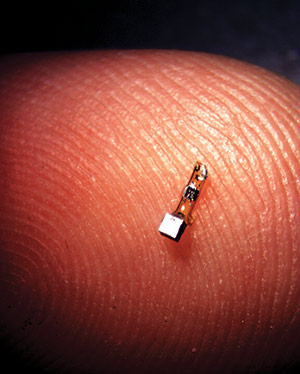Neural dust

This micro-sensor implant measures 3 mm in length. (Photo courtesy the researchers)
Berkeley engineers have created the first dust-sized sensor that can be implanted in the human body. The device, about the size of a large grain of sand, uses ultrasound — which can penetrate nearly anywhere in the body — to power and read out measurements. The sensor contains a piezoelectric crystal that converts ultrasound vibrations from outside the body into electricity to power a tiny, on-board transistor that is in contact with a nerve or muscle fiber. The sensor could monitor internal nerves, muscles or organs in real time, as well as stimulate nerves and muscles — possibly leading to new treatments for epilepsy, immune system disorders or inflammation. The technology may also lead to improved brain-machine interface technology and better brain control of prosthetics. Electrical engineering and computer sciences professors Michel Maharbiz and Jose Carmena are the study’s main authors; graduate students Dongjin Seo, Ryan Neely and Konlin Shen, undergraduate Utkarsh Singhal and professors Elad Alon and Jan Rabaey co-authored the study.
